

植物生态学报 ›› 2024, Vol. 48 ›› Issue (1): 113-126.DOI: 10.17521/cjpe.2022.0348 cstr: 32100.14.cjpe.2022.0348
祖姆热提•于苏甫江1, 董正武1,*( ), 成鹏2, 叶茂3, 刘隋赟昊1, 李生宇4, 赵晓英1
), 成鹏2, 叶茂3, 刘隋赟昊1, 李生宇4, 赵晓英1
收稿日期:2022-08-29
接受日期:2023-03-13
出版日期:2024-01-20
发布日期:2024-01-02
通讯作者:
(基金资助:
Zumureti YUSUFUJANG1, DONG Zheng-Wu1,*( ), CHENG Peng2, YE Mao3, LIU Sui-Yun-Hao1, LI Sheng-Yu4, ZHAO Xiao-Ying1
), CHENG Peng2, YE Mao3, LIU Sui-Yun-Hao1, LI Sheng-Yu4, ZHAO Xiao-Ying1
Received:2022-08-29
Accepted:2023-03-13
Online:2024-01-20
Published:2024-01-02
Contact:
(Supported by:摘要:
多枝柽柳(Tamarix ramosissima)作为干旱荒漠区的优势树种, 其与风沙长期作用过程中形成了柽柳沙堆, 研究沙堆上多枝柽柳水分利用来源及其对各水源的利用比例, 可为干旱荒漠区原生植被的保护及恢复提供科学依据。该研究以空间序列代替时间序列的方法, 通过野外调查及室内模型分析, 解析了不同发育阶段沙堆上多枝柽柳的水分来源及其对各水源的利用比例, 揭示了沙堆堆积过程中多枝柽柳的水分利用策略。结果表明: (1)多枝柽柳沙堆土壤水分含量随沙堆堆积增高而存在较大差异, 且0-500 cm层土壤平均水分含量依次为雏形阶段(4.57%) >增长阶段(4.46%) >衰退阶段(3.62%) >稳定阶段(3.48%); (2)雏形及增长阶段沙堆土壤含水率在40-180 cm层显著升高, 稳定及衰退阶段沙堆土壤含水率分别在180-360 cm和360-500 cm层显著升高。(3)各发育阶段沙堆上, 0-40 cm层土壤含水率及稳定氧同位素比值(δ18O)波动较大, 季节变化明显, 且随土层深度的增加δ18O趋于稳定, 表明表层土壤受外界环境影响较大。(4)春季, 多枝柽柳在雏形阶段沙堆上主要利用360-500 cm层土壤水, 其次利用0-40 cm层土壤水, 利用比例分别为53.1%和21.4%; 增长阶段沙堆上主要利用0-40和360-500 cm层土壤水, 利用比例分别为53.1%和23.0%; 稳定阶段沙堆上主要利用0-40和180-360 cm层土壤水, 利用比例分别为49.8%和29.3%; 衰退阶段沙堆上主要利用360-500 cm层土壤水, 利用比例为60.9%。夏季, 多枝柽柳在雏形和增长阶段沙堆上主要利用360-500 cm层土壤水, 利用比例分别为61.1%和42.8%, 且在增长阶段沙堆上还利用40-180和180-360 cm层土壤水; 稳定阶段沙堆上其对各层土壤水的利用较为均匀, 而衰退阶段沙堆上主要吸收180-360和360-500 cm层土壤水, 利用比例分别为29.0%和44.1%。秋季, 雏形阶段沙堆上以360-500 cm层土壤水为主要水源, 增长和稳定阶段沙堆上均以180-360和360-500 cm层土壤水为主要水源, 衰退阶段沙堆上主要利用360-500 cm深层土壤水, 利用比例高达92.3%, 反映出多枝柽柳在不同发育阶段沙堆上呈现出不同的水分利用策略。
祖姆热提•于苏甫江, 董正武, 成鹏, 叶茂, 刘隋赟昊, 李生宇, 赵晓英. 多枝柽柳水分利用策略对沙堆堆积过程的响应. 植物生态学报, 2024, 48(1): 113-126. DOI: 10.17521/cjpe.2022.0348
Zumureti YUSUFUJANG, DONG Zheng-Wu, CHENG Peng, YE Mao, LIU Sui-Yun-Hao, LI Sheng-Yu, ZHAO Xiao-Ying. Response of water use strategies of Tamarix ramosissima to nebkhas accumulation process. Chinese Journal of Plant Ecology, 2024, 48(1): 113-126. DOI: 10.17521/cjpe.2022.0348
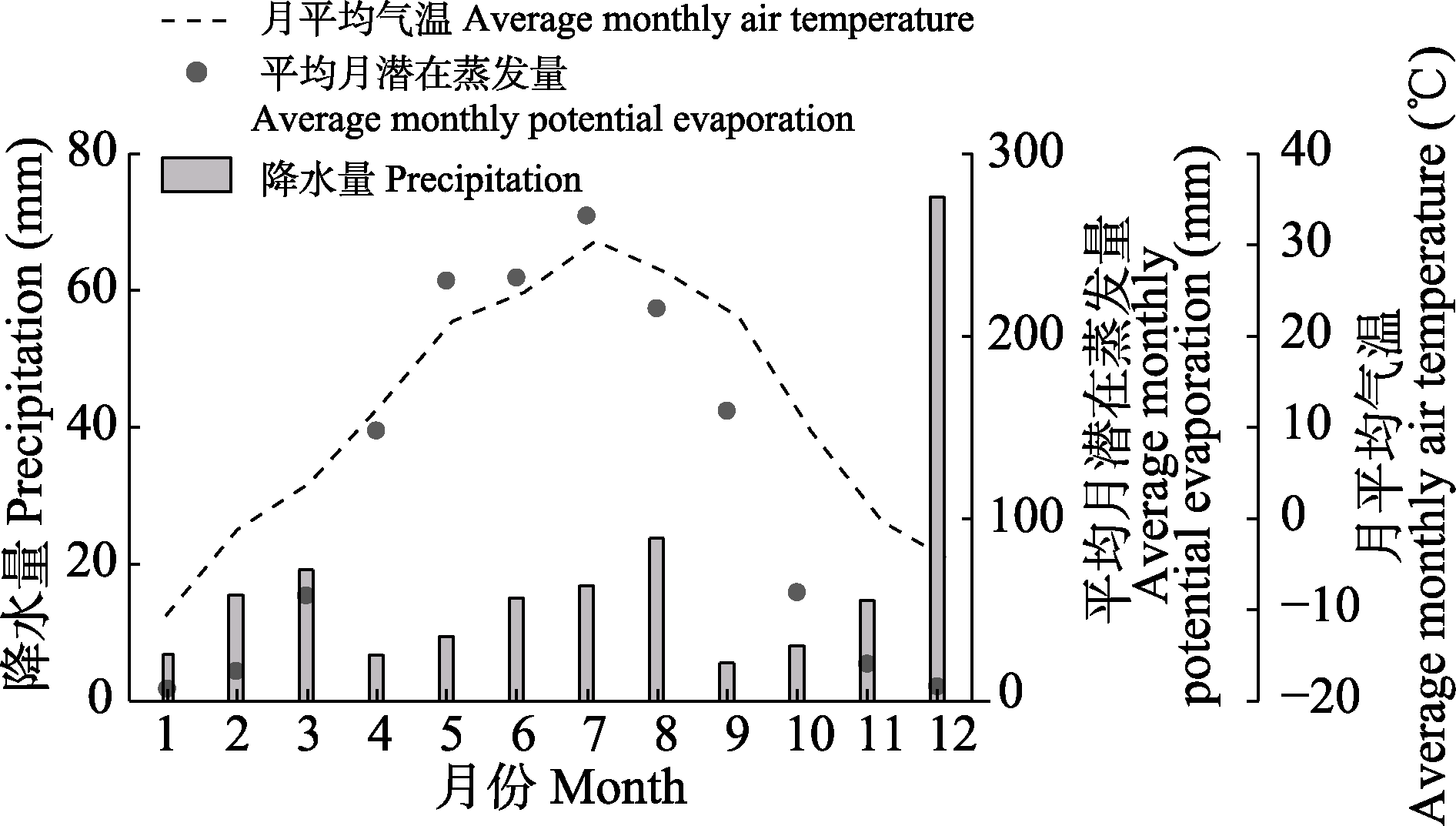
图1 古尔班通古特沙漠研究区2021年月降水量、潜在蒸发量及气温变化。
Fig. 1 Monthly precipitation, potential evaporation and air temperature changes in the study area in Gurbantünggüt Desert in 2021.
| 发育阶段 Developmental stage | 沙堆形态特征 Morphological characteristic | 土壤、结皮特征 Soil and soil crust characteristic | 植被特征 Vegetation characteristic |
|---|---|---|---|
| 雏形阶段 Embryonic stage | 沙堆体积较小, 形态不规则, 形态参数间相关性不强 The nebkhas are small in size, irregular in morphology, and the correlation between morphological parameters is not strong | 沙堆迎风坡和背风坡基本为流沙, 表面无结皮 Nebkhas are basically quicksand with no crust on the surface | 多以单个灌丛形式生长, 无结实, 迎风坡植被少, 长势较好 Mostly in the form of individual scrub, with little vegetation on windward slopes and good growth |
| 增长阶段 Growth stage | 沙堆体积较大, 形态接近锥体, 形态参数间相关性较好 The nebkhas are large in size, the morphology is close to that of vertebrae, and the correlation between morphological parameters is good | 迎风坡为流沙, 背风坡有少量结皮 Drifting sand on windward slopes, a few crusts on leeward slopes | 多个灌丛形式生长, 长势较好, 结实率高, 迎风坡出现植被, 植被盖度大于背风坡 Multiple scrub growth, good growth, high fruiting rate, vegetation on windward slopes, vegetation cover greater than on leeward slopes |
| 稳定阶段 Stable stage | 沙堆体积大, 形态接近半椭球体, 形态参数间相关性较好 The nebkhas are large in size, the morphology is close to semi-ellipsoidal, and the correlation between morphological parameters is good | 迎风坡和背风坡均有结皮, 结皮发育较完整, 结皮面积>70% Crusts are present on both windward and leeward slopes, crusts are relatively well developed, crust surface > 70% | 多个灌丛形式生长, 迎风坡植被盖度略大于背风坡, 枯枝率低 Multiple scrub growth, slightly more vegetation cover on windward slopes than on leeward slopes, low dieback rate |
| 衰退阶段 Decline stage | 沙堆体积较大, 形态接近半椭球体, 沙堆两侧风蚀崩塌, 形态参数间相关性差 The nebkhas are large in size, the morphology is close to semi-ellipsoidal, the sand piles are collapsed by wind and moisture on both sides, and the correlation between morphological parameters is poor | 沙堆表面结皮破坏严重, 风蚀较明显, 结皮面积<50% Nebkhas surface crust damage is serious, wind erosion is obvious, crust area is < 50% | 多个灌丛形式生长, 自疏现象严重, 枯枝率高, 结实率低, 植株主要分布于沙堆边缘 Multiple scrub growth, serious self-thinning phenomenon, high rate of dead branches, low fruiting rate, plants mainly distributed at the edge of the nebkhas |
表1 古尔班通古特沙漠不同发育阶段多枝柽柳灌丛沙堆划分依据
Table 1 Basis for developmental stage classification of Tamarix ramosissima scrub nebkhas in Gurbantünggüt Desert
| 发育阶段 Developmental stage | 沙堆形态特征 Morphological characteristic | 土壤、结皮特征 Soil and soil crust characteristic | 植被特征 Vegetation characteristic |
|---|---|---|---|
| 雏形阶段 Embryonic stage | 沙堆体积较小, 形态不规则, 形态参数间相关性不强 The nebkhas are small in size, irregular in morphology, and the correlation between morphological parameters is not strong | 沙堆迎风坡和背风坡基本为流沙, 表面无结皮 Nebkhas are basically quicksand with no crust on the surface | 多以单个灌丛形式生长, 无结实, 迎风坡植被少, 长势较好 Mostly in the form of individual scrub, with little vegetation on windward slopes and good growth |
| 增长阶段 Growth stage | 沙堆体积较大, 形态接近锥体, 形态参数间相关性较好 The nebkhas are large in size, the morphology is close to that of vertebrae, and the correlation between morphological parameters is good | 迎风坡为流沙, 背风坡有少量结皮 Drifting sand on windward slopes, a few crusts on leeward slopes | 多个灌丛形式生长, 长势较好, 结实率高, 迎风坡出现植被, 植被盖度大于背风坡 Multiple scrub growth, good growth, high fruiting rate, vegetation on windward slopes, vegetation cover greater than on leeward slopes |
| 稳定阶段 Stable stage | 沙堆体积大, 形态接近半椭球体, 形态参数间相关性较好 The nebkhas are large in size, the morphology is close to semi-ellipsoidal, and the correlation between morphological parameters is good | 迎风坡和背风坡均有结皮, 结皮发育较完整, 结皮面积>70% Crusts are present on both windward and leeward slopes, crusts are relatively well developed, crust surface > 70% | 多个灌丛形式生长, 迎风坡植被盖度略大于背风坡, 枯枝率低 Multiple scrub growth, slightly more vegetation cover on windward slopes than on leeward slopes, low dieback rate |
| 衰退阶段 Decline stage | 沙堆体积较大, 形态接近半椭球体, 沙堆两侧风蚀崩塌, 形态参数间相关性差 The nebkhas are large in size, the morphology is close to semi-ellipsoidal, the sand piles are collapsed by wind and moisture on both sides, and the correlation between morphological parameters is poor | 沙堆表面结皮破坏严重, 风蚀较明显, 结皮面积<50% Nebkhas surface crust damage is serious, wind erosion is obvious, crust area is < 50% | 多个灌丛形式生长, 自疏现象严重, 枯枝率高, 结实率低, 植株主要分布于沙堆边缘 Multiple scrub growth, serious self-thinning phenomenon, high rate of dead branches, low fruiting rate, plants mainly distributed at the edge of the nebkhas |
 |
表2 古尔班通古特沙漠不同发育阶段多枝柽柳灌丛植被特征和沙堆形态特征(平均值±标准误)
Table 2 Vegetation and morphology characteristics of Tamarix ramosissima nebkhas in different developmental stages in Gurbantünggüt Desert (mean + SE)
 |
| 发育阶段 Developmental stage | 月份 Month | 平均值 Mean | ||
|---|---|---|---|---|
| 5 | 7 | 9 | ||
| 雏形阶段 Embryonic stage | 5.08 ± 1.56aA | 4.48 ± 1.96aA | 4.12 ± 1.30aA | 4.57 ± 1.61 |
| 增长阶段 Growth stage | 4.39 ± 1.49aA | 4.44 ± 1.87aA | 4.56 ± 1.73aA | 4.44 ± 1.70 |
| 稳定阶段 Stable stage | 4.10 ± 0.42aA | 3.34 ± 0.77aA | 2.99 ± 0.66aA | 3.48 ± 0.59 |
| 衰退阶段 Decline stage | 3.69 ± 1.03aA | 4.00 ± 1.18aA | 3.18 ± 1.40aA | 3.62 ± 1.20 |
表3 不同发育阶段多枝柽柳沙堆土壤含水率(%)季节变化特征(平均值±标准误)
Table 3 Seasonal variation characteristics of soil water content (%) of Tamarix ramosissima nebkhas at different developmental stages (mean ± SE)
| 发育阶段 Developmental stage | 月份 Month | 平均值 Mean | ||
|---|---|---|---|---|
| 5 | 7 | 9 | ||
| 雏形阶段 Embryonic stage | 5.08 ± 1.56aA | 4.48 ± 1.96aA | 4.12 ± 1.30aA | 4.57 ± 1.61 |
| 增长阶段 Growth stage | 4.39 ± 1.49aA | 4.44 ± 1.87aA | 4.56 ± 1.73aA | 4.44 ± 1.70 |
| 稳定阶段 Stable stage | 4.10 ± 0.42aA | 3.34 ± 0.77aA | 2.99 ± 0.66aA | 3.48 ± 0.59 |
| 衰退阶段 Decline stage | 3.69 ± 1.03aA | 4.00 ± 1.18aA | 3.18 ± 1.40aA | 3.62 ± 1.20 |
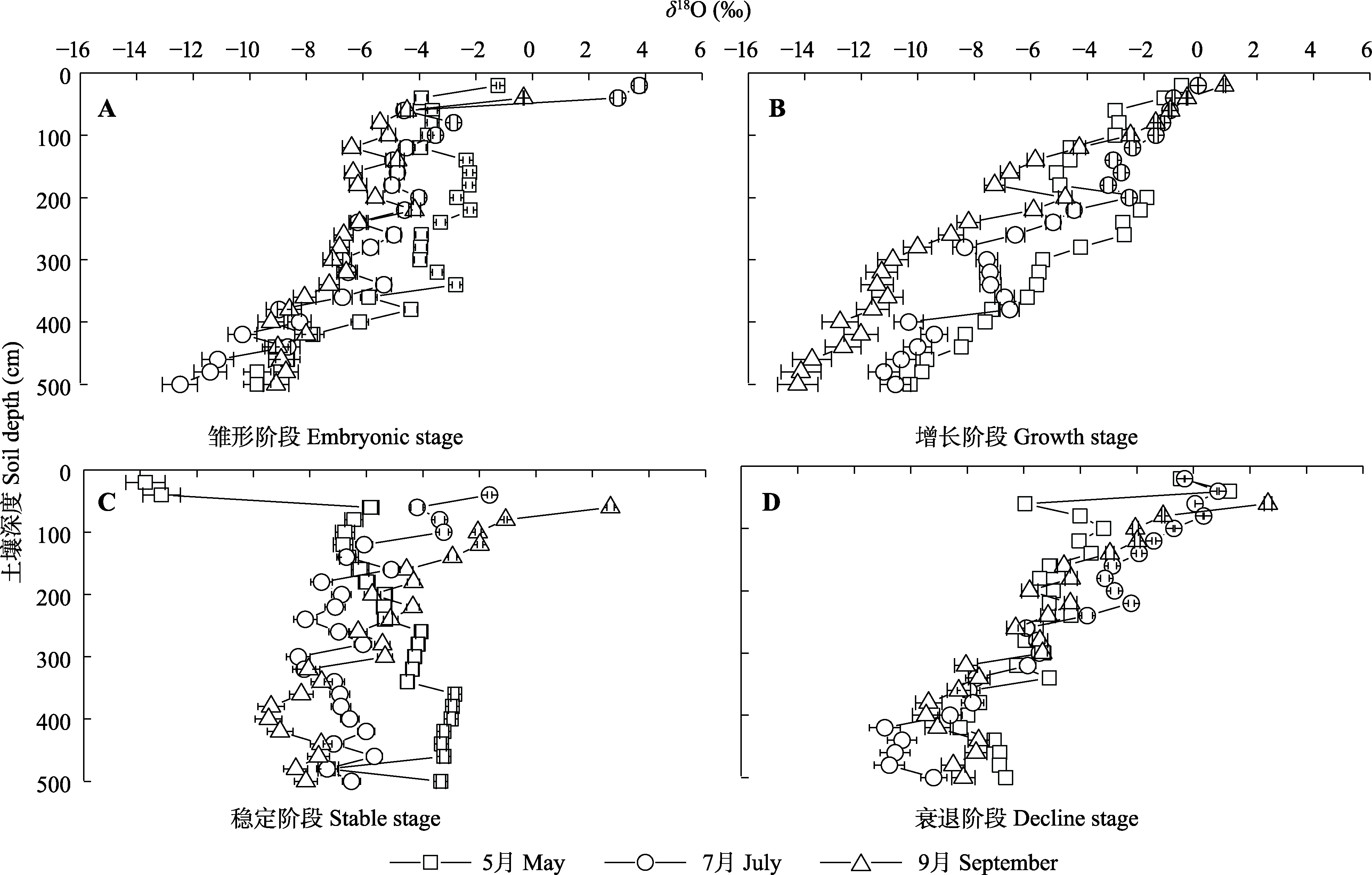
图3 不同发育阶段多枝柽柳沙堆土壤水稳定氧同位素比值(δ18O)的变化(平均值±标准误)。
Fig. 3 Changes in soil water stable oxygen isotope ratio (δ18O) of Tamarix ramosissima nebkhas at different developmental stages (mean ± SE).
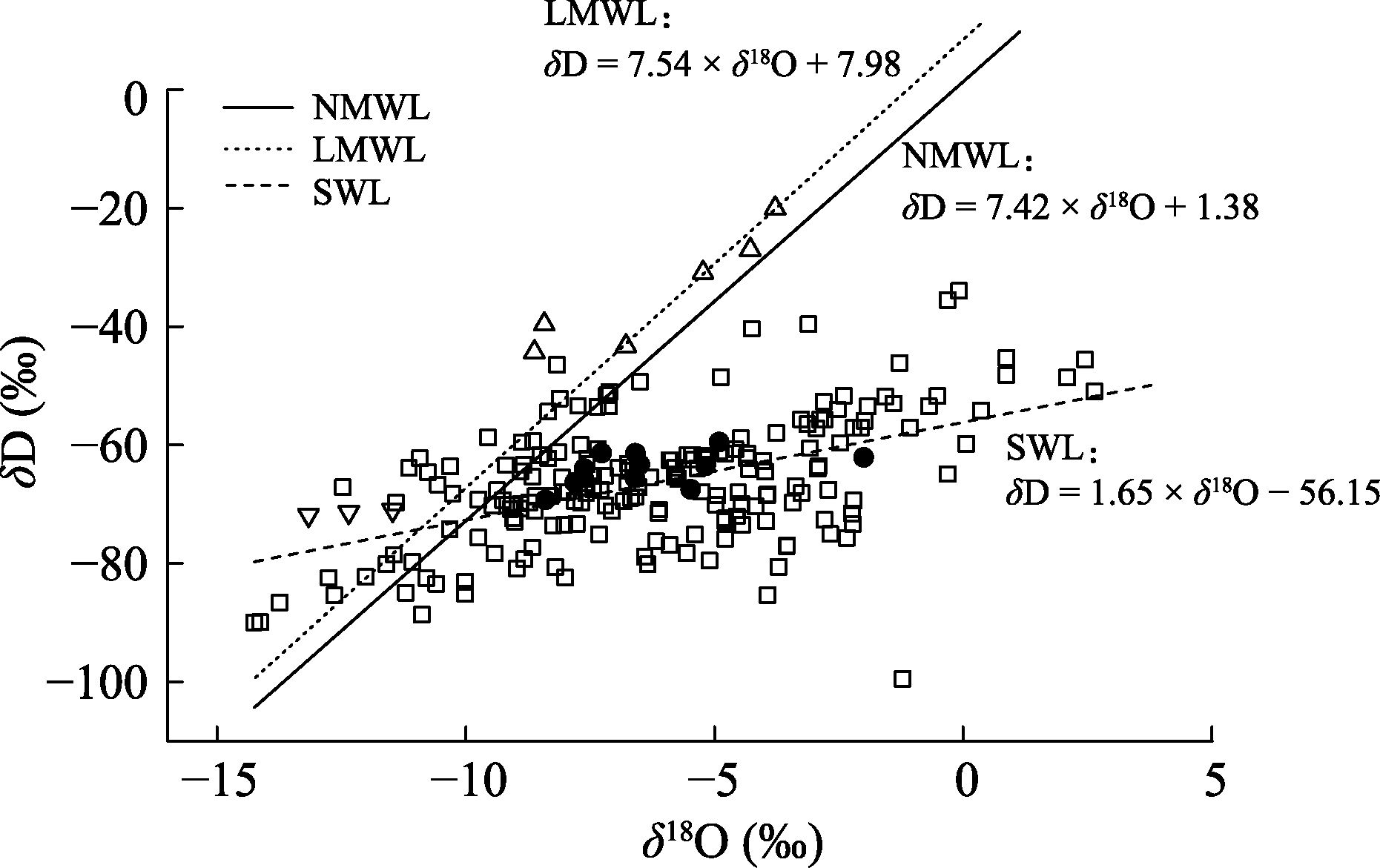
图4 降水(Δ )、土壤水($\square$ )、地下水(▽ )、多枝柽柳木质部水(●)稳定氢、氧同位素比值(δD、δ18O)的线性回归关系。LMWL, 局地大气水线; NMWL, 西北干旱区大气水线; SWL, 土壤水线。
Fig. 4 Linear regression between stable oxygen and hydrogen isotope ratio (δD and δ18O) in rainfall (Δ ), soil water ($\square$ ), groundwater (▽ ), and xylem water (●) of Tamarix ramosissima. LMWL, local meteoric water line; NMWL, northwest arid region meteoric water line; SWL, soil water line.
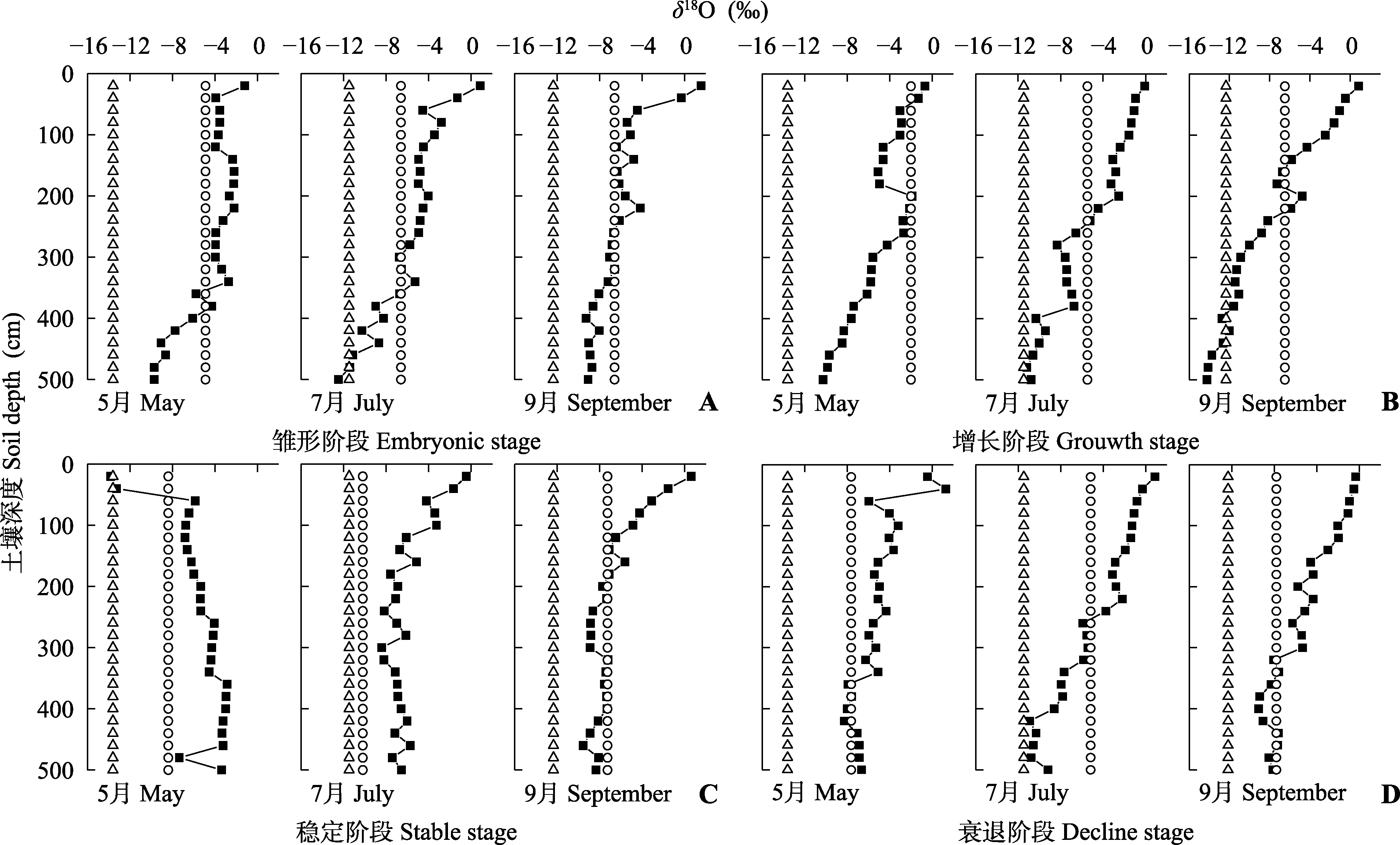
图5 不同发育阶段土壤水(▇ )、地下水(Δ )与多枝柽柳木质部水分(○)稳定氧同位素比值(δ18O)的季节变化。
Fig. 5 Seasonal variation of stable oxygen isotope ratio (δ18O) of soil water (▇ ), groundwater (Δ ) and xylem water (○) of Tamarix ramosissima.
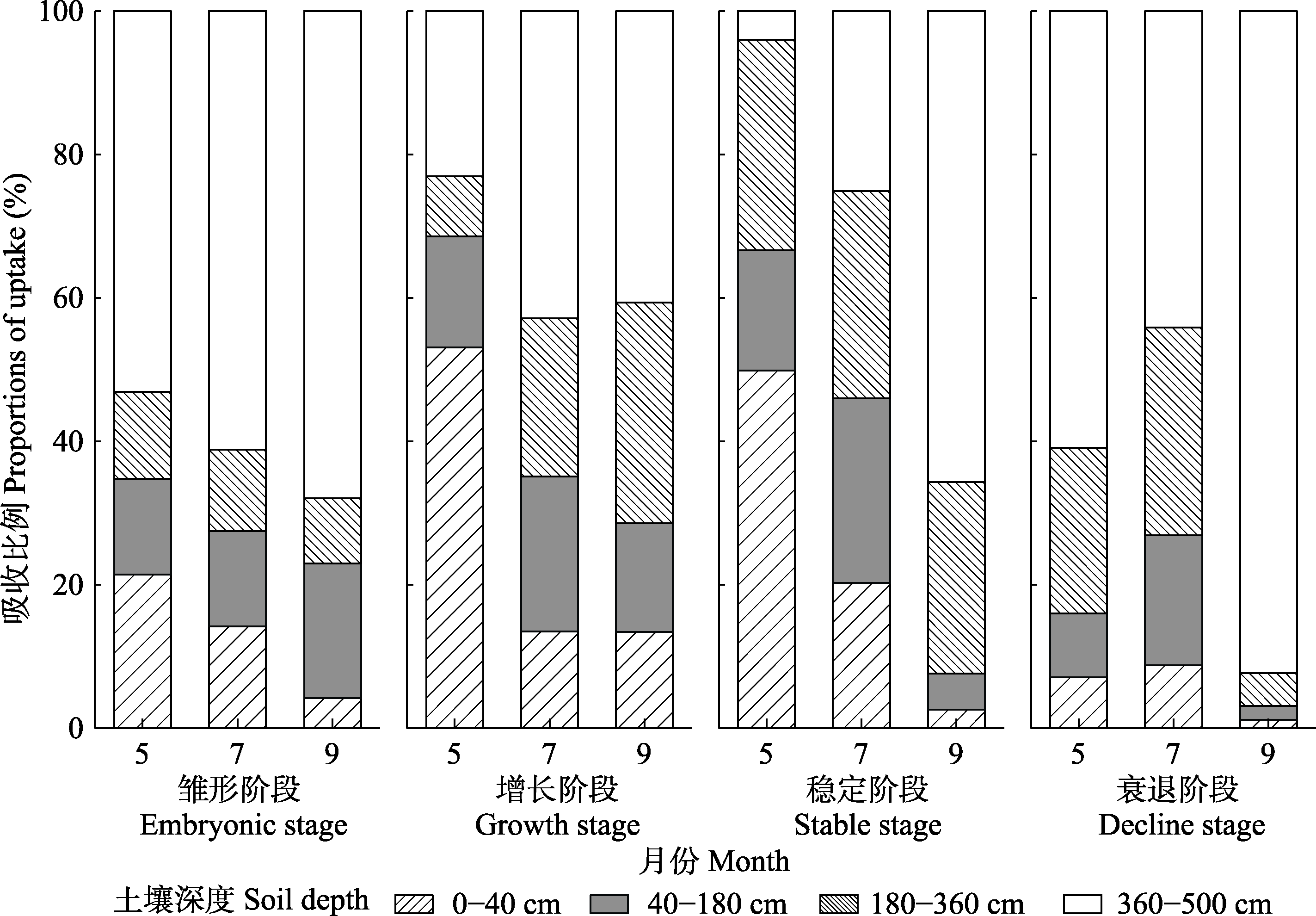
图6 不同发育阶段沙堆上的多枝柽柳对潜在水源的利用比例。
Fig. 6 Water use proportion of each potential source for Tamarix ramosissima at nebkhas of different developmental stages.
| [1] |
Chen YP, Chen YN, Xu CC, Li WH (2016). The effects of groundwater depth on water uptake of Populus euphratica and Tamarix ramosissima in the hyperarid region of Northwestern China. Environmental Science and Pollution Research, 23, 17404-17412.
DOI URL |
| [2] | Chen YW, Li HL, Dong Z, Geng LS, Pan JC, Shang B (2022). Soil improvement effect and quality evaluation of three sand-fixing materials combined with aeolian sandy soil. Research of Soil and Water Conservation, 29, 48-54. |
| [陈艺文, 李红丽, 董智, 耿林昇, 潘嘉琛, 尚宾 (2022). 3种固沙材料与风沙土复配后土壤改良效应及其质量评价. 水土保持研究, 29, 48-54.] | |
| [3] |
Dai Y, Zheng XJ, Tang LS, Li Y (2015). Stable oxygen isotopes reveal distinct water use patterns of two Haloxylon species in the Gurbantonggut Desert. Plant and Soil, 389, 73-87.
DOI URL |
| [4] |
Ding JY, Zhao WW, Fu BJ, Wang S, Fan H (2018). Variability of Tamarix spp. characteristics in riparian plant communities are affected by soil properties and accessibility of anthropogenic disturbance in the lower reaches of Heihe River, China. Forest Ecology and Management, 410, 174-186.
DOI URL |
| [5] | Dong ZW, Li SY, Mao DL, Lei JQ (2021). Distribution pattern of soil grain size in Tamarix sand dune in the southwest of Gurbantunggut Desert. Journal of Soil and Water Conservation, 35, 64-72. |
| [董正武, 李生宇, 毛东雷, 雷加强 (2021). 古尔班通古特沙漠西南缘柽柳沙包土壤粒度分布特征. 水土保持学报, 35, 64-72.] | |
| [6] |
Dong ZW, Li SY, Zhao Y, Lei JQ, Wang YD, Li CJ (2020). Stable oxygen-hydrogen isotopes reveal water use strategies of Tamarix taklamakanensis in the Taklimakan Desert, China. Journal of Arid Land, 12, 115-129.
DOI |
| [7] |
Du JH, Yan P, Dong YX (2010). The progress and prospects of nebkhas in arid areas. Acta Geographica Sinica, 65, 339-350.
DOI |
| [杜建会, 严平, 董玉祥 (2010). 干旱地区灌丛沙堆研究现状与展望. 地理学报, 65, 339-350.] | |
| [8] | Ehleringer JR, Dawson TE (1992). Water uptake by plants: perspectives from stable isotope composition. Plant, Cell & Environment, 15, 1073-1082. |
| [9] | Fu SH, Hu SJ, Li H, Wang ZF (2018). Water sources of dominant plants in Haloxylon ammodendron community at the southern edge of Gurbantunggut desert. Journal of Desert Research, 38, 1024-1032. |
|
[傅思华, 胡顺军, 李浩, 王泽锋 (2018). 古尔班通古特沙漠南缘梭梭(Haloxylon ammodendron)群落优势植物水分来源. 中国沙漠, 38, 1024-1032.]
DOI |
|
| [10] |
Gui ZY, Qin SG, Hu Z, Bai F, Shi HS, Zhang YQ (2021). Foliar condensate absorption and its pathways of two typical shrub species in the Mu Us Desert. Chinese Journal of Plant Ecology, 45, 583-593.
DOI URL |
| [桂子洋, 秦树高, 胡朝, 白凤, 石慧书, 张宇清 (2021). 乌素沙地两种典型灌木叶片凝结水吸收能力及吸水途径. 植物生态学报, 45, 583-593.] | |
| [11] |
Hao S, Li FD (2021). Water sources of the typical desert vegetation in Ebinur Lake Basin. Acta Geographica Sinica, 76, 1649-1661.
DOI |
|
[郝帅, 李发东 (2021). 艾比湖流域典型荒漠植被水分利用来源研究. 地理学报, 76, 1649-1661.]
DOI |
|
| [12] | Huang X, Chen YN, Li WH, Liu JZ, Chen YP (2006). Analysis of soil carbon fluxes and their influencing factors in Tamarisk communities in the middle and lower reaches of the Tarim River. Environmental Science, 10, 1934-1940. |
| [黄湘, 陈亚宁, 李卫红, 刘加珍, 陈亚鹏 (2006). 塔里木河中下游柽柳群落土壤碳通量及其影响因子分析. 环境科学, 10, 1934-1940.] | |
| [13] |
Li YF, Yu JJ, Lu K, Wang P, Zhang YC, Du CY (2017). Water sources of Populus euphratica and Tamarix ramosissima in Ejina Delta, the lower reaches of the Heihe River, China. Chinese Journal of Plant Ecology, 41, 519-528.
DOI URL |
|
[李亚飞, 于静洁, 陆凯, 王平, 张一驰, 杜朝阳 (2017). 额济纳三角洲胡杨和多枝柽柳水分来源解析. 植物生态学报, 41, 519-528.]
DOI |
|
| [14] | Liu FY, You QG, Xue X, Peng F, Huang CH, Ma SX, Pan J, Shi YF, Chen XJ (2022). The stem sap flow and water sources for Tamarix ramosissima in an artificial shelterbelt with a deep groundwater table in northwest China. Frontiers in Plant Science, 13, 794084. DOI: 10.3389/fpls.2022.794084. |
| [15] |
Liu JR, Song XF, Yuan GF, Sun XM, Liu X, Chen F, Wang ZM, Wang SQ (2009). Characteristics of atmospheric precipitation δ18O and water vapor sources in Northwest China. Journal of Geographical Sciences, 19, 164-174.
DOI URL |
| [16] | Liu MT (1995). Comprehensive Utilization of Tamarix spp. and Large-scale Application. Lanzhou University Press, Lanzhou. |
| [刘铭庭 (1995). 柽柳属植物综合利用研究及大面积推广应用. 兰州大学出版社, 兰州.] | |
| [17] |
Liu ZQ, Yu XX, Jia GD (2018). Water utilization characteristics of typical vegetation in the rocky mountain area of Beijing, China. Ecological Indicators, 91, 249-258.
DOI URL |
| [18] |
Luo WC, Zhao WZ, Liu B (2016). Growth stages affect species richness and vegetation patterns of nebkhas in the desert steppes of China. Catena, 137, 126-133.
DOI URL |
| [19] | Meng DK, Min XJ, Zang YX, Ma JY (2019). Leaf nutrient characteristics and water use strategy of Tamarix ramosissima in artificial shelterbelt and natural community in south margin of the Taklamakan Desert, China. Chinese Journal of Ecology, 38, 3245-3253. |
| [孟德坤, 闵孝君, 臧永新, 马剑英 (2019). 塔克拉玛干沙漠南缘人工防护林和自然群落多枝柽柳叶片养分特征与水分利用策略. 生态学杂志, 38, 3245-3253.] | |
| [20] |
Meng XJ, Wen XF, Zhang XY, Han JY, Sun XM, Li XB (2012). Potential impacts of organic contaminant on δ18O and δD in leaf and xylem water detected by isotope ratio infrared spectroscopy. Chinese Journal of Eco-Agriculture, 20, 1359-1365.
DOI URL |
| [孟宪菁, 温学发, 张心昱, 韩佳音, 孙晓敏, 李晓波 (2012). 有机物对红外光谱技术测定植物叶片和茎秆水δ18O和δD的影响. 中国生态农业学报, 20, 1359-1365.] | |
| [21] | Miao BL, Pei H, Jiang YF, Jia CZ, Wu H (2020). Classification of surface morphology of sand cover and morphological characteristics and developmental process. Meteorology Journal of Inner Mongolia, (5), 37-42. |
| [苗百岭, 裴浩, 姜艳丰, 贾成朕, 吴昊 (2020). 沙被表面形态分类及形态特征与发育过程. 内蒙古气象, (5), 37-42.] | |
| [22] | Mu GJ (1994). The environmental significance of vegetation cones of the Taklimakan Desert, China. Arid Zone Research, 11, 34-41. |
| [穆桂金 (1994). 塔克拉玛干沙漠灌草丘的发育特征及环境意义. 干旱区研究, 11, 34-41.] | |
| [23] | Pu HM, Song WF, Wu JK (2020). Using soil water stable isotopes to investigate soil water movement in a water conservation forest in Hani Terrace. Water, 12, 3520. DOI: 10.3390/w12123520. |
| [24] | Qian YB, Wu ZN, Zhang LY, Shi QD, Jiang J, Tang LS (2004). Impact of habitat heterogeneity on plant community pattern in Gurbantunggut Desert. Journal of Geographical Sciences, 14, 447-455. |
| [25] | Su PY, Zhang MJ, Qu DY, Wang JX, Zhang Y, Yao XY, Xiao HY (2020). Contrasting water use strategies of Tamarix ramosissima in different habitats in the northwest of loess plateau, China. Water, 12, 2791. DOI: 10.3390/w12102791. |
| [26] |
Tiemuerbieke B, Min XJ, Zang YX, Xing P, Ma JY, Sun W (2018). Water use patterns of co-occurring C3and C4 shrubs in the Gurbantonggut Desert in northwestern China. The Science of the Total Environment, 634, 341-354.
DOI URL |
| [27] | Wang HJ, Tian LH, Zhang HW, Yu Y, Wu HW (2022). Water uptake by Artemisia ordosica roots at different topographic positions in an alpine desert dune on the northeastern Qinghai-Tibet Plateau. Frontiers in Earth Science, 10, 686441. DOI: 10.3389/feart.2022.686441. |
| [28] |
West AG, Goldsmith GR, Matimati I, Dawson TE (2011). Spectral analysis software improves confidence in plant and soil water stable isotope analyses performed by isotope ratio infrared spectroscopy (IRIS). Rapid Communications in Mass Spectrometry, 25, 2268-2274.
DOI PMID |
| [29] |
Wu X, Zheng XJ, Yin XW, Yue YM, Liu R, Xu GQ, Li Y (2019). Seasonal variation in the groundwater dependency of two dominant woody species in a desert region of Central Asia. Plant and Soil, 444, 39-55.
DOI |
| [30] | Xia JQ, Zhang B, Li JX, Sun SF, Wang R (2021). Effects of litter mulching on micro-environment and seedling settlement of Stellera chamaejasme in alpine grassland. Acta Agrestia Sinica, 29, 1909-1915. |
|
[夏建强, 张勃, 李佳欣, 孙淑范, 汪睿 (2021). 高寒草地凋落物覆盖对狼毒生长微环境及种苗定居的影响. 草地学报, 29, 1909-1915.]
DOI |
|
| [31] |
Yang F, Wang XQ, Yang DL, Han ZY (2012). Research on the morphological interactions between Tamarix ramosissima thickets and nebkhas under different sand supply conditions: a case study in Cele oasis-desert ecotone. Acta Ecologica Sinica, 32, 2707-2719.
DOI URL |
| [杨帆, 王雪芹, 杨东亮, 韩章勇 (2012). 不同沙源供给条件下柽柳灌丛与沙堆形态的互馈关系——以策勒绿洲沙漠过渡带为例. 生态学报, 32, 2707-2719.] | |
| [32] |
Zeng F, Lu Y, Liu B, Guo H, Zeng J, Zhang L, Arndt SK (2013). One-year-old seedling biomass distribution and root architecture characteristics differed between two desert plants: Tamarix ramosissima and Alhagi sparsifolia. Arid Land Research and Management, 27, 298-302.
DOI URL |
| [33] | Zhan XL, Yan P, Wang N, Yang DZ, Qi B (2011). Soil characteristics in measurements areas of desertification combating and mobile dune around Qinghai Lake. Ecology and Environmental Sciences, 20, 292-297. |
|
[展秀丽, 严平, 王宁, 杨典正, 齐彪 (2011). 环青海湖固沙治理区与流动沙丘土壤特征研究. 生态环境学报, 20, 292-297.]
DOI |
|
| [34] |
Zhang H, Li M, Wells RR, Liu Q (2019). Effect of soil water content on soil detachment capacity for coarse- and fine-grained soils. Soil Science Society of America Journal, 83, 697-706.
DOI |
| [35] |
Zhang JH, Wang NA, Niu ZM, Sun J, Dong CY, Zhang LL (2018). Stable isotope analysis of water sources for Tamarix laxa in the mega-dunes of the Badain Jaran Desert, China. Journal of Arid Land, 10, 821-832.
DOI |
| [36] | Zhang Y, Zhang MJ, Qu DY, Duan WG, Wang JX, Su PY, Guo R (2020). Water use strategies of dominant species (Caragana korshinskii and Reaumuria soongorica) in natural shrubs based on stable isotopes in the loess hill, China. Water, 12, 1923. DOI: 10.3390/w12071923. |
| [37] | Zhang YF, Wei YF, Liao ZL, Xu XM, Han ZH, Liang WT, Long YH, Guo JY (2020). Determination of soil-groundwater systems recharge mechanism in the middle Inner Mongolia Plateau by isotopic tracers. Environmental Earth Sciences, 79, 473. DOI: 10.1007/s12665-020-09226-6. |
| [38] | Zhao X, Zhang XY, Li QS, Zhou MX (2004). Influence of sandy desertification on Tamarix community in Ejin Oasis. Journal of Desert Reseach, 24, 89-98. |
| [赵雪, 张小由, 李启森, 周茅先 (2004). 额济纳绿洲沙漠化对柽柳群落影响的研究. 中国沙漠, 24, 89-94.] | |
| [39] | Zhao Y, Wang L, Knighton J, Evaristo J, Wassen M (2021). Contrasting adaptive strategies by Caragana korshinskii and Salix psammophila in a semiarid revegetated ecosystem. Agricultural and Forest Meteorology, 300, 108323. DOI: 10.1016/j.agrformet.2021.108323. |
| [40] | Zhao YJ, Xia XC (2011). Study of Tamarix Cones and Environment in Lop Nor Region, Xinjiang. Science Press, Beijing. |
| [赵元杰, 夏训诚 (2011). 新疆罗布泊红柳沙包与环境研究. 科学出版社, 北京.] | |
| [41] |
Zhou H, Zheng XJ, Tang LS, Li Y (2013). Differences and similarities between water sources of Tamarix ramosissima, Nitraria sibirica and Reaumuria soongorica in the southeastern Junggar Basin. Chinese Journal of Plant Ecology, 37, 665-673.
DOI URL |
|
[周海, 郑新军, 唐立松, 李彦 (2013). 准噶尔盆地东南缘多枝柽柳、白刺和红砂水分来源的异同. 植物生态学报, 37, 665-673.]
DOI |
| [1] | 马佳正 陈雨婷 马松梅 张丹 贺凌云. 基于GIS和多源数据的沙漠植物白梭梭遗传格局与扩散路径模拟[J]. 植物生态学报, 2024, 48(预发表): 0-0. |
| [2] | 张潇, 武娟娟, 贾国栋, 雷自然, 张龙齐, 刘锐, 吕相融, 代远萌. 降水控制对侧柏液流变化特征及其水分来源的影响[J]. 植物生态学报, 2023, 47(11): 1585-1599. |
| [3] | 张庆, 尹本丰, 李继文, 陆永兴, 荣晓莹, 周晓兵, 张丙昌, 张元明. 荒漠藓类植物死亡对表层土壤酶活性的影响[J]. 植物生态学报, 2022, 46(3): 350-361. |
| [4] | 臧永新, 马剑英, 周晓兵, 陶冶, 尹本丰, 沙亚古丽•及格尔, 张元明. 极端干旱和降水对沙垄不同坡向坡位短命植物地上生产力的影响[J]. 植物生态学报, 2022, 46(12): 1537-1550. |
| [5] | 侯宝林, 庄伟伟. 古尔班通古特沙漠一年生植物的氮吸收策略[J]. 植物生态学报, 2021, 45(7): 760-770. |
| [6] | 李亚飞, 于静洁, 陆凯, 王平, 张一驰, 杜朝阳. 额济纳三角洲胡杨和多枝柽柳水分来源解析[J]. 植物生态学报, 2017, 41(5): 519-528. |
| [7] | 吕婷, 赵西宁, 高晓东, 潘燕辉. 黄土丘陵区典型天然灌丛和人工灌丛优势植物土壤水分利用策略[J]. 植物生态学报, 2017, 41(2): 175-185. |
| [8] | 陈定帅, 董正武, 高磊, 陈效民, 彭新华, 司炳成, 赵英. 不同降水条件下科尔沁沙地小叶锦鸡儿和盐蒿的水分利用动态[J]. 植物生态学报, 2017, 41(12): 1262-1272. |
| [9] | 尹本丰, 张元明, 娄安如. 灌丛移除对荒漠齿肋赤藓越冬过程中生理生化特性的影响[J]. 植物生态学报, 2016, 40(7): 723-734. |
| [10] | 尹本丰,张元明. 荒漠区不同微生境下齿肋赤藓对一次降雪的生理生化响应[J]. 植物生态学报, 2014, 38(9): 978-989. |
| [11] | 肖遥,陶冶,张元明. 古尔班通古特沙漠4种荒漠草本植物不同生长期的生物量分配与叶片化学计量特征[J]. 植物生态学报, 2014, 38(9): 929-940. |
| [12] | 戴岳,郑新军,唐立松,李彦. 古尔班通古特沙漠南缘梭梭水分利用动态[J]. 植物生态学报, 2014, 38(11): 1214-1225. |
| [13] | 朱林,祁亚淑,许兴. 宁夏盐池不同坡位旱地紫苜蓿水分来源[J]. 植物生态学报, 2014, 38(11): 1226-1240. |
| [14] | 周海,郑新军,唐立松,李彦. 准噶尔盆地东南缘多枝柽柳、白刺和红砂水分来源的异同[J]. 植物生态学报, 2013, 37(7): 665-673. |
| [15] | 鱼腾飞, 冯起, 司建华. 极端干旱区多枝柽柳叶片气孔导度的环境响应模拟[J]. 植物生态学报, 2012, 36(6): 483-490. |
| 阅读次数 | ||||||
|
全文 |
|
|||||
|
摘要 |
|
|||||
Copyright © 2022 版权所有 《植物生态学报》编辑部
地址: 北京香山南辛村20号, 邮编: 100093
Tel.: 010-62836134, 62836138; Fax: 010-82599431; E-mail: apes@ibcas.ac.cn, cjpe@ibcas.ac.cn
备案号: 京ICP备16067583号-19